Managing Thermal Characteristics in Network Servers
Advanced Enclosure Designs and Air Flow Techniques Hold the Key to Success
Overview of Global Trends in Network Server Deployments
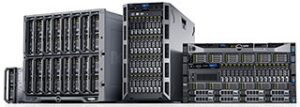
Over the past year, the network server market has seen a significant resurgence in growth after experiencing a few years of shrinking sales. According to the latest figures from IDC, worldwide server shipments increased 20.7% year over year to 2.7 million units in Q1 of 2018 and revenue rose 38.6%. Average selling prices (ASPs) also increased during the quarter due to richer configurations and increased component costs. The increased ASPs also contributed to revenue growth. Volume server revenue increased by 41.3% to US$15.9 billion, while midrange server revenue grew 31% to $1.7 billion. High-end systems grew 20.1% to $1.2 billion.
A key element that drives the unit and revenue growth is the rise of “hyperscale data centers” that offer the ability to expand and contract computing resources based on the needs of the business. Because hyperscale data centers can adjust via software to accommodate a wide range of requirements and load balancing across many different customers and changing demand levels, the segregation of hardware is giving way to larger, faster and more powerful systems.
Instead of the separate racks, storage, routers, staff support and management tools that were common in previous data centers, today’s environments tend towards the consolidation of computing power, which is then allocated as needed via software.
For network server designers and manufacturers, the new opportunities for selling high-end server hardware also come with a new set of challenges. One of the biggest challenges is the need for improved thermal management because of the heat generated by high performance chips, more densely packed circuit boards, multiple storage devices, faster communications interfaces, and the bigger power supply units required for these complex systems.
Various Approaches for Thermal Management
System design engineers can use several methods to help mitigate thermal issues, all of which have their respective pros and cons. These approaches include:
- Natural Convection – using ambient air flow to cool components in the system. However, air is not inherently a good conductor of heat.
- Forced Convection – using fans to move higher volumes of air over heat-generating components, which improves the cooling process. However, the use of fans can take up valuable space and also add some complexity in the form of circuitry to manage the fans.
- Heat Sinks – attaching copper or aluminum finned structures to heat-generating components to increase the effectiveness of heat removal via additional surface area. However, heat sinks also take up additional space in the system.
- Coolants – using fluids with high latent heat capacity and thermal conductivity to cool specialized heat sinks. However, the design of coolant flow structures can be complex and expensive.
- Component Placement – designing circuit boards to minimize heat generation and avoid hot spots from groupings of high heat-generating components.
Designing and Testing for Optimal Cooling Performance
When it comes to optimizing thermal performance, two things hold true:
- There is not a one-size-fits-all solution because each system is unique.
- Heat mitigation methods cannot be treated as an afterthought. To be successful, they must be treated as an integral part of the design process from-the-ground-up.

The following sections provide a brief overview of the process for evaluating, designing and testing optimal thermal management mechanisms for network server systems and enclosures.
The first step is using advanced thermal and flow simulation to determine optimal placement of components, power supplies, thermal management devices and chassis design alternatives.
Multiple simulations are often needed to test different air flow routing methods, plenum designs, chassis perforation configurations, etc. This up-front simulation process is critical to evaluate the projected thermal performance of alternatives and to focus design efforts.
During the simulation process, special attention needs to be given to the flow trajectories surrounding the Power Supply Unit (PSU), which is typically one of the highest heat-generating elements in any system. PSU placement and flow patterns are critical to make sure that heat from the power supply is effectively carried out of the chassis without impact on heat-sensitive components.
The iterative simulation process should also explore different component placement layouts in relation to the PSU placement. Design of heat flow channels, such as isolating the PSU flow away from the overall chassis flow, is the key to avoiding unintended aggregation of heat from multiple sources and assuring efficient removal of heat from the system.
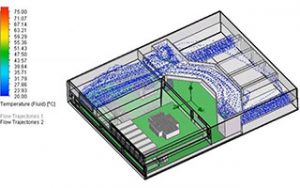
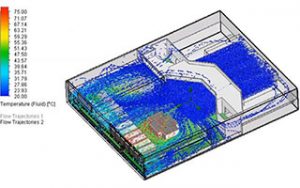
The iterative simulation process should also explore different component placement layouts in relation to the PSU placement. Design of heat flow channels, such as isolating the PSU flow away from the overall chassis flow, is the key to avoiding unintended aggregation of heat from multiple sources and assuring efficient removal of heat from the system.
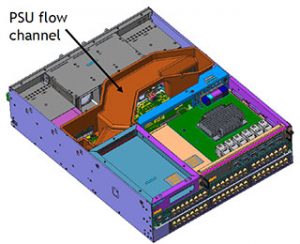
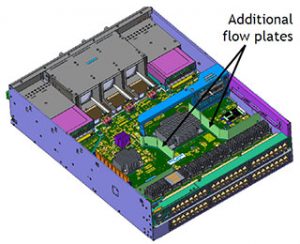
Detailed simulation and analysis should then be used to focus on the heat levels of individual components within the system. These projected heat levels need to remain within the safety margins of thermal conditions for each component in the system, especially critical components or those with special sensitivity to heat.
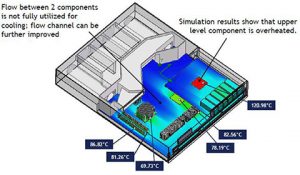
Summary
As network servers become more complex and powerful, with massive data centers packing more servers within finite space constraints, the need for effective thermal management continues to be one of the most critical factors for overall success.
As described above, the design and optimization of air movement within each chassis requires close attention not only to pressure and flow characteristics, but also to flow distribution and channeling properties. Optimizing the system for air flow and thermal performance is an iterative process, most easily done before major layout or architectural properties have been fixed.
Close collaboration between thermal analysts, board layout engineers, and system architects has proven to be the most effective method for optimizing complete server design.
For best results, it is also important to involve enclosure production specialists that have proven Design for Excellence methodologies and a broad range of expertise in thermal analysis for assuring optimized designs. It’s important to remember that your enclosure is much more than just a metal box that can be built by any vendor. In reality, the enclosure is one of the most important components in your system design; it is imperative for it to meet critical specifications for keeping all components inside the chassis running optimally and to deliver long-life performance.
For more information
To find out more about our Datacom & Telecom solutions, visit our Products by Market Segments webpage or drop us an email at
communications@interplex.com.




